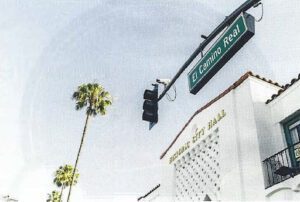By Christine Lampert, Architect, AIA, NCARB
Photos courtesy of Michelle Marie Photography
The tall white building at the top of Avenida Del Mar has a golden sign that says Historic City Hall. Most people probably assume this to be true, but in fact, this building was never San Clemente’s City Hall building.
The actual “historic” city hall was most likely up the street a few blocks at El Camino Real and Avenida Miramar. Today, that building houses an independent press agency called Zuma Press, and there is very little information available about the building’s history.
The Historic City Hall building at the top of Avenida Del Mar is also called the Easley Building, named after the man who built it in 1929. The building did serve as the city clerk’s office, and over the years has housed a Bank of America, business offices, a music store and a San Clemente history museum. Today, the office spaces are rented out to various businesses by the current owner.
Oscar Easley was one of the original residents of San Clemente. He was the concrete contractor for many of the original buildings and sidewalks in town. He served on the first city council and he was the commissioner of streets and sidewalks for the city.
Easley poured the concrete foundation for Ole Hanson’s house, the Casa Romantica. His company also laid out the original paved street along El Camino Real. Two years after paving El Camino Real, Easley acquired the property across the street from Ole Hanson’s administrative offices (104-118 N. El Camino Real) to build his office building.
The two-story Easley Building is 9,845 square feet and contains 22 offices. The architect that Easley hired was one of the most well-known at the time, Virgil Westbrook. He incorporated many Moorish designs into the Easley Building.
Many of the buildings in town were designed by Westbrook, including the Bartlett Building across the street (100 S. El CaminoReal) and the Hotel San Clemente (now the Hotel San Clemente Apartments) just down the street at 114 Avenida Del Mar. He also designed the Ole Hanson Beach Club in North Beach.

Photos courtesy of Michelle Marie Photography
Westbrook’s designs were inspirational and magical. He knew how to incorporate the fine and fluid details of Spanish Revival Architecture into _his projects, and his proportions were perfect. San Clemente’s founder, Ole Hanson, was a big fan of Westbrook’s work, and hired him to design many of the community buildings in town. In fact, Westbrook probably designed more buildings in San Clemente than any other architect.
The Easley Building was built by the Strang Brothers, the contractors who built many of the commercial buildings, as well as homes in early San Clemente.
Oscar Easley’s legacy as the concrete contractor in town can still be seen on some of the historical sidewalks around town, which say “O.F. Easley Contractor.” One piece of stamped sidewalk that came from Max Berg Plaza Park has been preserved by the San Clemente Historical Society. Max Berg Plaza Park at 1100 Calle Puente was one of the first places constructed in 1926 when the city was founded.
At some point, the Easley Building was renamed Historic City Hall, possibly by a property owner trying to capitalize on the building’s historic significance. It may never have officially been San Clemente’s city hall, but the Easley Building remains a picturesque reminder of the architects and builders who constructed our beautiful Spanish Village by the Sea in the 192Gs.
Christine Lampert of Lampert Dias Architects is a member of the American Institute of Architects and is certified with the National Council of Architectural Registration Boards. She has lived in San Clemente for more than 45 years, and also resides part time in Hong Kong.
 Christine Lampert, Architect, AIA, NCARB
Christine Lampert, Architect, AIA, NCARB
